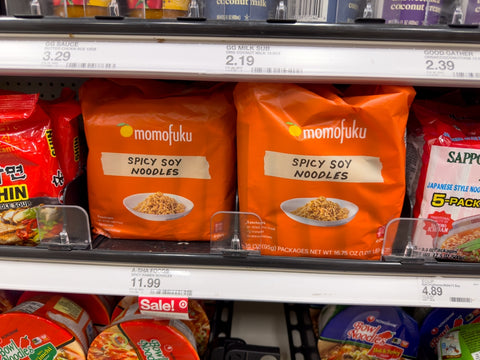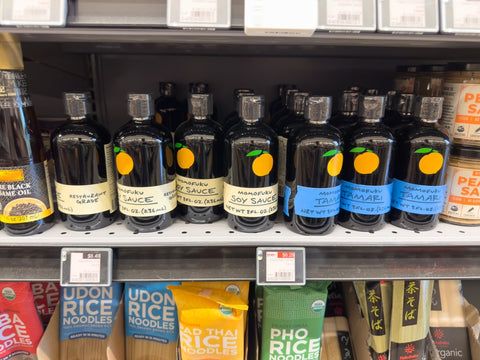Momofuku: Culinary Innovation from Noodle Bar to Global Brand
From a humble noodle bar to a global phenomenon, Momofuku’s rise to fame has been as chaotic as it is inspiring. There were times when the business had to run on survival mode, but today, it’s one of the most impactful restaurants in the US, with branches in Las Vegas, Los Angeles, and New York.
Momofuku is renowned for blending traditional Asian dishes with modern cooking techniques while patronizing local, sustainable sources. Some of their popular main dishes include noodles, buns, and seasonal Asian foods. Their ramen noodles and bo ssäm are famous within and outside of America. The Momofuku brand now includes an online shop where people can buy noodle packs, chili, and other seasonings and spices. Momofuku has not only changed how the world appreciates Asian food but also Asian culture.
This post explores every detail about Momofuku and its impact on modern cuisine. We’ll talk about their founder, philosophy, signature dishes, and lots more. But first, let’s go back to how it all started.
The Genesis of Momofuku Noodle Bar
In 2004, founder David Chang opened the first restaurant, Momofuku Noodle Bar, with money he borrowed from his father. Located in New York City, the first two years were the toughest. With 60% of restaurants in the US failing within their first year and 80% in five years, the odds were against Momofuku’s success. In the beginning, there seemed to be too much focus on trying to fit into an already saturated market and not enough innovation. As a result, Momofoku almost shut down.
Fortunes changed for the better when Momofuku Noodle Bar fully embraced its cultural heritage and began to focus on serving delicious yet accessible Korean foods. Dishes became more adventurous and unpredictable, with chefs cooking what they liked. The result was that more and more people began to fall in love with the restaurant and its fun-packed meals. Momofuku Noodle Bar hasn’t been short of regular customers since then. The brand swiftly moved to establish more restaurants. Below is a brief timeline of how Momofoku opened its chain of domestic and foreign restaurants:
-
Momofuku Noodle Bar (NYC) - 2004
-
Momofuku Ssäm Bar (NYC) - 2006
-
Momofuku Ko (NYC) - 2008
-
Má Pêche (NYC) - 2010
-
Momofuku Seiōbo (Sydney, Australia) - 2011
-
Momofuku Toronto (Toronto, Canada) - 2012
-
Momofuku Las Vegas (Las Vegas) - 2016
-
Majordōmo (Los Angeles) - 2018
David Chang: The Visionary Behind Momofuku

One of “the most influential people of the 21st century,” GQ’s Man of the Year, and Time 100 honoree. Those are accolades used to describe David Chang, the likable founder of Momofuku. However, there was a time when he was unknown, massively underrated, and shamed.
Growing up, David was surrounded by food lovers. His father worked in a restaurant for 30 years and his mother was excellent at cooking Korean dishes like kimchi and oxtail soup. However, because he resided in the US (Arlington, Virginia), he occasionally received jeers from people who had little respect for Asian cuisine and culture. This underappreciation would later form the basis of his and Momofuku’s culinary philosophy.
After graduating from Trinity College, Connecticut, David worked as an English teacher in Japan and also in finance. However, he was unhappy with his life and career, so he enrolled in the French Culinary Institute and soon got jobs in kitchens and restaurants. It was during this phase of his career that his passion for Asian food blossomed.
Despite his father’s disapproval, David managed to borrow enough money from him to open Momofuku Noodle Bar in 2004. His main driving force was a strong belief that good food shouldn’t be reserved for the wealthy. The rest is history!
Momofuku's Culinary Philosophy: Breaking Traditions
The culinary philosophy behind Momofuku was born when David noticed a stark difference between the food cultures in East Asia and New York City. In countries like Japan, good food was available to anyone. People of all wealth and social classes could be found eating at the same ramen joints or sushi bars. On the other hand, good food in NYC was a lot more inaccessible. Fine-dining cost a lot of money and was mostly available at restaurants with entry rules.
Momofuku Noodle Bar was opened to bring a more accessible approach to NYC’s culinary scene. At first, things didn’t go as planned and the restaurant struggled. Fortunately, embracing a more cross-cultural approach proved to be the missing link, and Momofuku’s journey to becoming a global empire finally took off.
Signature Dishes: What Makes Momofuku Stand Out

Several signature Momofuku dishes have captivated food enthusiasts worldwide. Many of them are traditional Asian dishes prepared using contemporary techniques and global flavors. Check them out:
-
Bo Ssäm: The Momofuku bo ssäm is one of the restaurant’s most beloved dishes. It consists of roasted pork shoulder served alongside an ample helping of rice, lettuce, and some Korean sauces.
-
Momofuku Bao: This is Momofuku’s signature pork belly bun. The buns are steamed with tasty pork belly, scallions, hoisin sauce, and cucumbers. David Chang himself admitted that he owes most of his success to the bao.
-
Momofuku Ramen: This is a fun and unique take on umami-rich Japanese noodle soup. It includes pork noodles and eggs.
-
Shiitake Mushroom Buns: Momofuk’s bao (pork belly bun) needed a vegetarian alternative, so they came up with the idea of using shiitake mushrooms as filling. And it worked!
-
Ginger Scallion Noodles: Initially a noodle bar, Momofuku offered a variety of delicious noodle recipes. One of them included noodles topped with ginger and scallion sauce. Today, you can enjoy some of their noodle recipes without leaving your home, thanks to products like Momofuku x A-Sha Premium Instant Noodles.
Momofuku Noodle Bar: The Flagship Experience

What does it feel like to visit a Momofuku Noodle Bar today? What stands out upon entry is the atmosphere. From ramen-themed decorations to a fun playlist of songs, the bar fills visitors with energy and eager anticipation.
Although the menu focuses on ramen and other noodle dishes, there are other food options for customers to enjoy. Offerings include fried chicken, rice cakes, different types of ramen, steamed buns, truffle ball cakes, crispy rice, and sauce-topped eggs.
Visiting Momofuku: Tips for the Ultimate Dining Experience
Now that you know what to expect at a typical Momofuku restaurant, it’s time for some tips to help you have the best time during your visit.
-
Go there early to avoid having to wait, especially on a weekend.
-
Momofuku pork belly is a must-try meal.
-
The Ssäm sauce served at the restaurant tastes great with everything, so don’t hesitate to enjoy it.
-
After your dinner, don’t forget to stop by the Momofuku Milk Bar in NYC for dessert.
-
Keep in mind that the Momofuku Noodle Bar at East Village accepts reservations for up to 14 days, while the Uptown (Columbus Circle) bar accepts reservations for up to 30 days.
Expansion and Evolution: Momofuku Las Vegas and Beyond
There have been more than 14 Momofuku establishments since the first one back in 2004. The brand has milk bars, cocktail bars, takeout shops, and more. There are plans to expand even further in the coming years.
In 2017, David opened one of the brand’s most successful restaurants, Momofuku Las Vegas. This was the empire’s first attempt at serving the Western US market. Momofuku Las Vegas offers dishes from all over the world, especially the US, Japan, and Korea. You can expect to enjoy a variety of steam buns, seafood, noodles, and meat.
David Chang's Influence on Global Cuisine
David Chang’s impact on the world’s view of Asian food transcends his work with Momofuku. In 2018, he released a Netflix docu-series titled: Ugly Delicious. This ran for two seasons and introduced viewers to mouthwatering cross-cultural dishes. His podcast, The David Chang Show, was also popular, with thousands tuning in for every episode. David Chang also created Lucky Peach, a culinary magazine, and a successful cookbook titled Momofuku.
Momofuku Retail Products: Bringing the Flavor Home

Momofuku also sells retail products ranging from sauces to seasonings. They allow fans to recreate Momofuku dishes at home. Some of the items include noodles, chili crunch, sauces, rice vinegar, and seasoned salt products. Two of our favorite Momofuku items are the Spicy Soy Noodles and the Soy & Scallion Noodles.
Momofuku Chili Crunch: A Taste of Innovation at Home
In 2019, Momofuku Goods was created with the aim of bringing restaurant-grade flavors to home kitchens. One of their best products is the Momofuku Chili Crunch, a spicy oil that adds heat and texture to any dish. It was released in 2020, with over 20,000 people on the prelaunch waiting list. The Momofuku Chili Crunch product line includes the following:
-
Chili Crunch Original
-
Chili Crunch Hot Honey
-
Chili Crunch Black Truffle Crunch
-
Chili Crunch Extra Spicy
The Momofuku Cookbook: From Restaurant to Home Kitchen
Earlier, we mentioned David Chang’s cookbook titled: Momofuku. Published in 2009, the book was written alongside co-writers Peter Meehan and Chris Ying. It described how to cook high-quality Asian-Asian dishes, especially ramen noodles. David also reveals his experience launching the Momofuku brand. The cookbook played a role in democratizing gourmet cooking, making Momofuku's innovative recipes accessible to home chefs.
Celebrity and Critic Acclaim: Awards and Recognition
Momofuku and David Chang have received several awards and critical acclaim, underscoring their influence in the culinary world. Let’s take a look at some of them:
-
8-time honoree of San Pellegrino World's 50 Best Restaurants: Momofuku
-
3 James Beard Awards: David Chang
-
1 James Beard Award: Momofoku
-
2 Michelin stars: Momofoku
-
2011 New York Times - The Five Most Influential Restaurants of the Past Six Years: Momofuku
-
2007 GQ’s Man of the Year: David Chang
-
2010 Time 100 honoree: David Chang
The Lasting Legacy of Momofuku
The impact of Momofuku on the culinary landscape surpasses their offering of good food to people of all backgrounds and social classes. It has successfully changed the global view of Asian-American cuisine and brought about a deeper appreciation of cross-cultural cooking. Whether you’re at home or in New York City, you can get a taste of Momofuku’s commitment to food when you drop by one of their restaurants or order their retail products.
Author Bio








